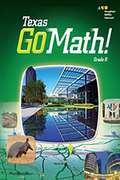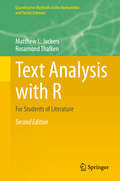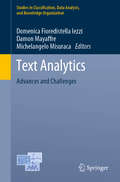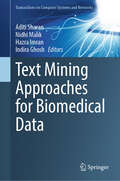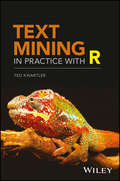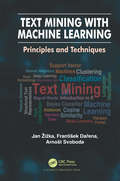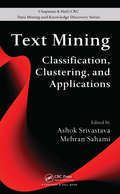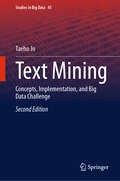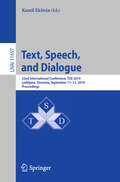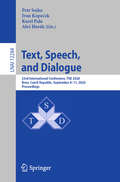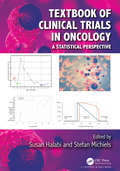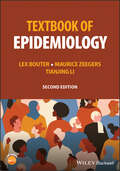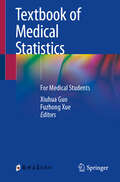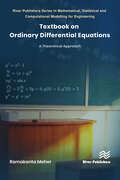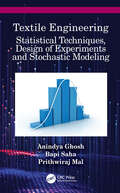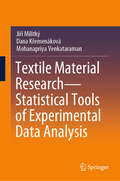- Table View
- List View
Texas Go Math! Grade 8
by Timothy D. Kanold Steven J. Leinwand Matthew R. Larson Martha E. Sandoval-MartinezIn this exciting mathematics program for 8th Graders, there are hands-on activities to do and real-world problems to solve.
Texas Go Math! Volume 1 (Grade #4)
by Edward B. Burger Juli K. Dixon Matthew R. Larson Martha E. Sandoval-MartinezMath Textbook for 4th Grade
Texas Go Math! Volume 2 Grade 3
by Houghton Mifflin HarcourtIn this exciting mathematics program for Grade 3, there are hands-on activities to do and real-world problems to solve.
Texas Mathematics, Grade 4
by Don S. Balka Mary Behr Altieri Roger DayMath textbook for Texas 4th graders.
Texas-Style Exclusion: Mexican Americans and the Legacy of Limited Opportunity
by James D. Bachmeier Jennifer Van HookWhile Americans largely support legal immigration, this support is conditional on the basis that immigrants do not make use of public assistance. Previous generations of immigrants, such as European-origin Industrial Era immigrants, came to U.S. impoverished, worked hard, and achieved the American Dream seemingly on their own. Mexican immigrants, the nation’s largest contemporary immigrant group, are often viewed with suspicion and are accused of being dependent on the government and refusing to integrate into American society the “right way.” In Texas-Style Exclusion, sociologists Jennifer Van Hook and James D. Bachmeier investigate such claims by comparing how American society has responded to different groups of immigrants over time. Drawing on census and archival data on the quality of public schooling, Van Hook and Bachmeier find that Industrial Era European immigrants, who were primarily located in the northeastern U.S., benefited from programs and policies championed by the Americanization and Progressive movements. The Americanization movement sought to help acclimate new arrivals and transform “foreigners” into “Americans” by providing night school programs to promote civic integration and basic education, as well as other services. The Progressive movement, which aimed to improve education, work, and health conditions, sought to expand investment in public schools and make primary and secondary schooling mandatory, which kept working class children in school as opposed to entering the workforce. This access to education allowed for integration and astonishing intergenerational mobility. Mexican immigrants in the 1920s and 1930s, the majority of whom resided in Texas, had radically different experiences from their European counterparts. Mexicans in Texas were subjected to racism, segregation, labor exploitation, and intentional school failures. This resulted in tremendous generational disadvantage that persists to the current day. Mexicans from this cohort who left Texas for states with strong Americanization and Progressive movements saw improved educational outcomes and integration. Additionally, Mexicans who immigrated after the Civil Rights Movement saw significantly greater inter-generational mobility and educational attainment than earlier cohorts due to the protections provided by civil rights laws. Van Hook and Bachmeier conclude that whether one is optimistic or pessimistic about the integration of Mexican Americans depends on when and where one looks. Texas-Style Exclusion is an engaging examination of policies and practices that have been glossed over and forgotten that promoted mobility and integration for certain immigrant groups and impeded them for others.
Text Analysis with R: For Students of Literature (Quantitative Methods in the Humanities and Social Sciences)
by Matthew L. Jockers Rosamond ThalkenNow in its second edition, Text Analysis with R provides a practical introduction to computational text analysis using the open source programming language R. R is an extremely popular programming language, used throughout the sciences; due to its accessibility, R is now used increasingly in other research areas. In this volume, readers immediately begin working with text, and each chapter examines a new technique or process, allowing readers to obtain a broad exposure to core R procedures and a fundamental understanding of the possibilities of computational text analysis at both the micro and the macro scale. Each chapter builds on its predecessor as readers move from small scale “microanalysis” of single texts to large scale “macroanalysis” of text corpora, and each concludes with a set of practice exercises that reinforce and expand upon the chapter lessons. The book’s focus is on making the technical palatable and making the technical useful and immediately gratifying. Text Analysis with R is written with students and scholars of literature in mind but will be applicable to other humanists and social scientists wishing to extend their methodological toolkit to include quantitative and computational approaches to the study of text. Computation provides access to information in text that readers simply cannot gather using traditional qualitative methods of close reading and human synthesis. This new edition features two new chapters: one that introduces dplyr and tidyr in the context of parsing and analyzing dramatic texts to extract speaker and receiver data, and one on sentiment analysis using the syuzhet package. It is also filled with updated material in every chapter to integrate new developments in the field, current practices in R style, and the use of more efficient algorithms.
Text Analytics: Advances and Challenges (Studies in Classification, Data Analysis, and Knowledge Organization)
by Domenica Fioredistella Iezzi Damon Mayaffre Michelangelo MisuracaFocusing on methodologies, applications and challenges of textual data analysis and related fields, this book gathers selected and peer-reviewed contributions presented at the 14th International Conference on Statistical Analysis of Textual Data (JADT 2018), held in Rome, Italy, on June 12-15, 2018. Statistical analysis of textual data is a multidisciplinary field of research that has been mainly fostered by statistics, linguistics, mathematics and computer science. The respective sections of the book focus on techniques, methods and models for text analytics, dictionaries and specific languages, multilingual text analysis, and the applications of text analytics. The interdisciplinary contributions cover topics including text mining, text analytics, network text analysis, information extraction, sentiment analysis, web mining, social media analysis, corpus and quantitative linguistics, statistical and computational methods, and textual data in sociology, psychology, politics, law and marketing.
Text Mining Approaches for Biomedical Data (Transactions on Computer Systems and Networks)
by Aditi Sharan Nidhi Malik Hazra Imran Indira GhoshThe book 'Text Mining Approaches for Biomedical Data' delves into the fascinating realm of text mining in healthcare. It provides an in-depth understanding of how Artificial Intelligence (AI) and Machine Learning (ML) are revolutionizing healthcare research and patient care. The book covers a wide range of topics such as mining textual data in biomedical and health databases, analyzing literature and clinical trials, and demonstrating various applications of text mining in healthcare. This book is a guide for effectively representing textual data using vectors, knowledge graphs, and other advanced techniques. It covers various text mining applications, building descriptive and predictive models, and evaluating them. Additionally, it includes building machine learning models using textual data, covering statistical and deep learning approaches. This book is designed to be a valuable reference for computer science professionals, researchers in the biomedical field, and clinicians. It provides practical guidance and promotes collaboration between different disciplines. Therefore, it is a must-read for anyone who is interested in the intersection of text mining and healthcare.
Text Mining in Practice with R
by Ted KwartlerA reliable, cost-effective approach to extracting priceless business information from all sources of text Excavating actionable business insights from data is a complex undertaking, and that complexity is magnified by an order of magnitude when the focus is on documents and other text information. This book takes a practical, hands-on approach to teaching you a reliable, cost-effective approach to mining the vast, untold riches buried within all forms of text using R. Author Ted Kwartler clearly describes all of the tools needed to perform text mining and shows you how to use them to identify practical business applications to get your creative text mining efforts started right away. With the help of numerous real-world examples and case studies from industries ranging from healthcare to entertainment to telecommunications, he demonstrates how to execute an array of text mining processes and functions, including sentiment scoring, topic modelling, predictive modelling, extracting clickbait from headlines, and more. You’ll learn how to: Identify actionable social media posts to improve customer service Use text mining in HR to identify candidate perceptions of an organisation, match job descriptions with resumes, and more Extract priceless information from virtually all digital and print sources, including the news media, social media sites, PDFs, and even JPEG and GIF image files Make text mining an integral component of marketing in order to identify brand evangelists, impact customer propensity modelling, and much more Most companies’ data mining efforts focus almost exclusively on numerical and categorical data, while text remains a largely untapped resource. Especially in a global marketplace where being first to identify and respond to customer needs and expectations imparts an unbeatable competitive advantage, text represents a source of immense potential value. Unfortunately, there is no reliable, cost-effective technology for extracting analytical insights from the huge and ever-growing volume of text available online and other digital sources, as well as from paper documents—until now.
Text Mining with Machine Learning: Principles and Techniques
by Jan Žižka František Dařena Arnošt SvobodaThis book provides a perspective on the application of machine learning-based methods in knowledge discovery from natural languages texts. By analysing various data sets, conclusions which are not normally evident, emerge and can be used for various purposes and applications. The book provides explanations of principles of time-proven machine learning algorithms applied in text mining together with step-by-step demonstrations of how to reveal the semantic contents in real-world datasets using the popular R-language with its implemented machine learning algorithms. The book is not only aimed at IT specialists, but is meant for a wider audience that needs to process big sets of text documents and has basic knowledge of the subject, e.g. e-mail service providers, online shoppers, librarians, etc. The book starts with an introduction to text-based natural language data processing and its goals and problems. It focuses on machine learning, presenting various algorithms with their use and possibilities, and reviews the positives and negatives. Beginning with the initial data pre-processing, a reader can follow the steps provided in the R-language including the subsuming of various available plug-ins into the resulting software tool. A big advantage is that R also contains many libraries implementing machine learning algorithms, so a reader can concentrate on the principal target without the need to implement the details of the algorithms her- or himself. To make sense of the results, the book also provides explanations of the algorithms, which supports the final evaluation and interpretation of the results. The examples are demonstrated using realworld data from commonly accessible Internet sources.
Text Mining: Classification, Clustering, and Applications (Chapman & Hall/CRC Data Mining and Knowledge Discovery Series)
by Ashok N. Srivastava Mehran SahamiThe Definitive Resource on Text Mining Theory and Applications from Foremost Researchers in the FieldGiving a broad perspective of the field from numerous vantage points, Text Mining: Classification, Clustering, and Applications focuses on statistical methods for text mining and analysis. It examines methods to automatically cluster and classify te
Text Mining: Concepts, Implementation, and Big Data Challenge (Studies in Big Data #45)
by Taeho JoThis popular book, updated as a textbook for classroom use, discusses text mining and different ways this type of data mining can be used to find implicit knowledge from text collections. The author provides the guidelines for implementing text mining systems in Java, as well as concepts and approaches. The book starts by providing detailed text preprocessing techniques and then goes on to provide concepts, the techniques, the implementation, and the evaluation of text categorization. It then goes into more advanced topics including text summarization, text segmentation, topic mapping, and automatic text management. The book features exercises and code to help readers quickly learn and apply knowledge.
Text, Speech, and Dialogue: 22nd International Conference, TSD 2019, Ljubljana, Slovenia, September 11–13, 2019, Proceedings (Lecture Notes in Computer Science #11697)
by Kamil EkšteinThis book constitutes the proceedings of the 22nd International Conference on Text, Speech, and Dialogue, TSD 2019, held in Ljubljana, Slovenia, in September 2019. The 33 full papers presented in this volume were carefully reviewed and selected from 73 submissions. They were organized in topical sections named text and speech. The book also contains one invited talk in full paper length.
Text, Speech, and Dialogue: 23rd International Conference, TSD 2020, Brno, Czech Republic, September 8–11, 2020, Proceedings (Lecture Notes in Computer Science #12284)
by Petr Sojka Aleš Horák Ivan Kopeček Karel PalaThis book constitutes the proceedings of the 23rd International Conference on Text, Speech, and Dialogue, TSD 2020, held in Brno, Czech Republic, in September 2020.*The 54 full papers presented in this volume were carefully reviewed and selected from 110 submissions. They were organized in topical sections named text, speech, and dialogue. The book also contains 3 invited talks.* The conference was held virtually due to the COVID-19 pandemic.
Textbook of Clinical Trials in Oncology: A Statistical Perspective
by Susan Halabi and Stefan MichielsThere is an increasing need for educational resources for statisticians and investigators. Reflecting this, the goal of this book is to provide readers with a sound foundation in the statistical design, conduct, and analysis of clinical trials. Furthermore, it is intended as a guide for statisticians and investigators with minimal clinical trial experience who are interested in pursuing a career in this area. The advancement in genetic and molecular technologies have revolutionized drug development. In recent years, clinical trials have become increasingly sophisticated as they incorporate genomic studies, and efficient designs (such as basket and umbrella trials) have permeated the field. This book offers the requisite background and expert guidance for the innovative statistical design and analysis of clinical trials in oncology. Key Features: Cutting-edge topics with appropriate technical background Built around case studies which give the work a "hands-on" approach Real examples of flaws in previously reported clinical trials and how to avoid them Access to statistical code on the book’s website Chapters written by internationally recognized statisticians from academia and pharmaceutical companies Carefully edited to ensure consistency in style, level, and approach Topics covered include innovating phase I and II designs, trials in immune-oncology and rare diseases, among many others
Textbook of Epidemiology
by Maurice Zeegers Tianjing Li Lex BouterTEXTBOOK OF EPIDEMIOLOGY The gold standard in epidemiological texts In the second edition of Textbook of Epidemiology, a distinguished team of researchers deliver an extensively updated and comprehensive exploration of epidemiological methods, illuminating the tools for studying the distribution and risk factors of health states and events in populations. An introduction to epidemiological methods with recent and broadly applicable examples End-of-chapter self-assessment questions for readers to check their understanding of key concepts, with answer keys and further enrichment materials available on a companion website A brand-new chapter covering methods for systematic reviews and meta-analysis Accessible material appropriate for clinical practitioners and researchers from around the world Perfect for professionals working in clinical medicine and public health, Textbook of Epidemiology will also earn a place in the libraries of allied health professionals seeking a one-stop resource or to re-immerse themselves in specific methodological topics and practices.
Textbook of Medical Statistics: For Medical Students
by Xiuhua Guo Fuzhong XueThis book introduces basic concepts, principle, and methods of medical statistics systematically and practically, especially in the statistical design of the experiment in terms of the specific problems, adequate use of statistical methods based on actual data and the reasonable explanation for statistical results.This textbook combines statistical methods with the common application of SPSS software, which is flexible, convenient, and user-friendly; thus, students can focus on the deep understanding of statistics.The authors emphasize the application and generalization of statistical methods, and combine these methods with the modern statistical theory, such as sequential contingency table and multivariate statistical modelling, etc.This book is a useful textbook for graduate and undergraduate students in medical schools, including MBBS (Bachelor of Medicine and Bachelor of Surgery) student.
Textbook on Ordinary Differential Equations: A Theoretical Approach
by Ramakanta MeherMany scientific and real-world problems that occur in science, engineering, and medicine can be represented in differential equations. There is a vital role for differential equations in studying the behavior of different types of real-world problems. Thus, it becomes crucial to know the existence and uniqueness properties of differential equations and various methods of finding differential equation solutions in explicit form. It is also essential to know different kinds of differential equations in terms of eigenvalues, termed eigenvalue problems, and some special functions used in finding the solution to differential equations. The study of nonlinear problems also plays a significant role in different real-world situations. There is a necessity to know the behavior of solutions of nonlinear differential equations. Still, there are very few forms of differential equations whose solution can be found in explicit form. For the differential equations whose solutions cannot be found in explicit form, one has to study the properties of solutions of the given differential equation to guess an approximate solution of it. This book aims to introduce all the necessary topics of differential equations in one book so that laymen can easily understand the subject and apply it in their research areas. The novel approach used in this book is the introduction of different analytical methods for finding the solution of differential equations with sufficient theorems, corollaries, and examples, and the geometrical interpretations in each topic. This textbook is intended to study the theory and methods of finding the explicit solutions to differential equations, wherever possible, and in the absence of finding explicit solutions, it is intended to study the properties of solutions to the given differential equations. This book is based on syllabi of the theory of differential equations prescribed for postgraduate students of mathematics and applied mathematics in different institutions and universities of India and abroad. This book will be helpful for competitive examinations as well.
Textile Engineering: Statistical Techniques, Design of Experiments and Stochastic Modeling
by Anindya Ghosh Prithwiraj Mal Bapi SahaFocusing on the importance of the application of statistical techniques, this book covers the design of experiments and stochastic modeling in textile engineering. Textile Engineering: Statistical Techniques, Design of Experiments and Stochastic Modeling focuses on the analysis and interpretation of textile data for improving the quality of textile processes and products using various statistical techniques. FEATURES Explores probability, random variables, probability distribution, estimation, significance test, ANOVA, acceptance sampling, control chart, regression and correlation, design of experiments and stochastic modeling pertaining to textiles Presents step-by-step mathematical derivations Includes MATLAB® codes for solving various numerical problems Consists of case studies, practical examples and homework problems in each chapter This book is aimed at graduate students, researchers and professionals in textile engineering, textile clothing, textile management and industrial engineering. This book is equally useful for learners and practitioners in other science and technological domains.
Textile Material Research—Statistical Tools of Experimental Data Analysis
by Mohanapriya Venkataraman Jiří Militký Dana KřemenákováThis book presents the effective combination of mathematical statistics, general metrology, and textile metrology to allow data analysis with regard to the evaluation of parameters of fibrous structures. Specialists working in material sciences, where fibrous structures are used, comprehensively understand the specifics of the fabric evaluation and manage in the context of rational use of selected mathematical and statistical methods. In this book, selected methods that are advantageous for data analysis, regardless of whether they are elementary or advanced are presented. The so-called computer-intensive methods are used in many situations when classical statistics is unable to offer a solution, or the solution is too complicated.
